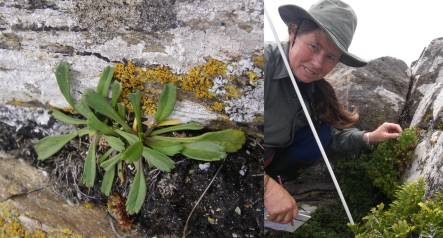
Juvenile Cooks scurvy grass, and Amanda Baird with her hand on a healthy adult plant growing next to a penguin burrow; the white pole marks the site (images: A. Ballance)
Rare plant botanist Amanda Baird works for the Department of Conservation on the Chatham Islands. Each summer she carries out monitoring of populations of ten or so highly threatened plants. Her smallest subject is Cooks scurvy grass (Lepidium oleraceum), which ranges in size from 1 centimetre midgets to flourishing adults that span a dinner plate. Cooks scurvy grass grows in narrow cracks on schist rocks almost at sea level, in locations highly exposed to salt and sea spray. The plants thrive in nutrient-rich locations such as seal colonies and shag colonies, and are highly threatened by grazing and browsing from introduced animals such as sheep and possums. Alison Ballance joins her to monitor plants at a number of sites on a small island at Point Munning, in the northeast of the main Chatham Island. Three forms of Cooks scurvy grass are found in the Chathams, with the Point Munning form known as 'B'. Amanda Baird was awarded the Loder Cup in 2007 for outstanding services to flora conservation. Cooks scurvy grass is named after Captain Cook, who fed the plant to his ship crews to prevent scurvy.

Stunted juvenile Cooks scurvy grass growing in a narrow rock crack (left), schist rocks at Point Munning, and an adult Cooks scurvy grass with abundant seeds (images: A. Ballance)


